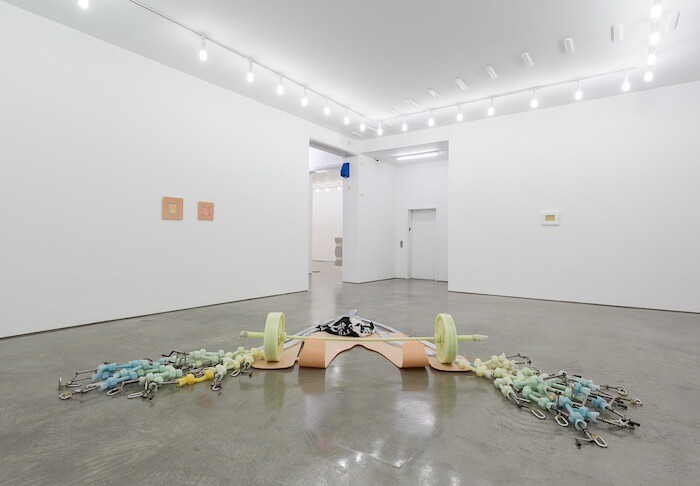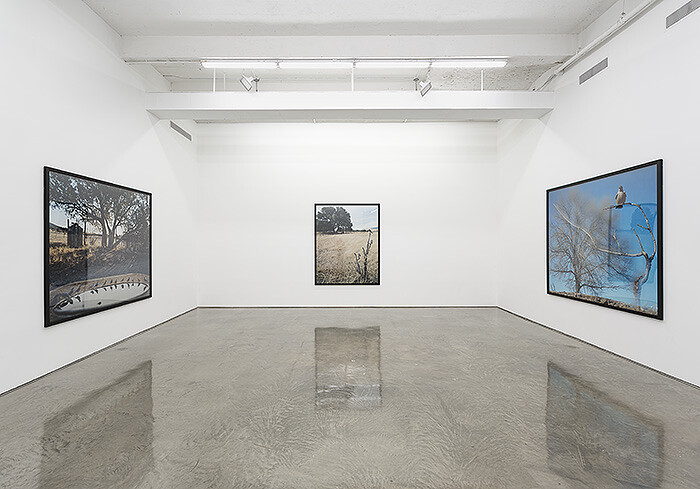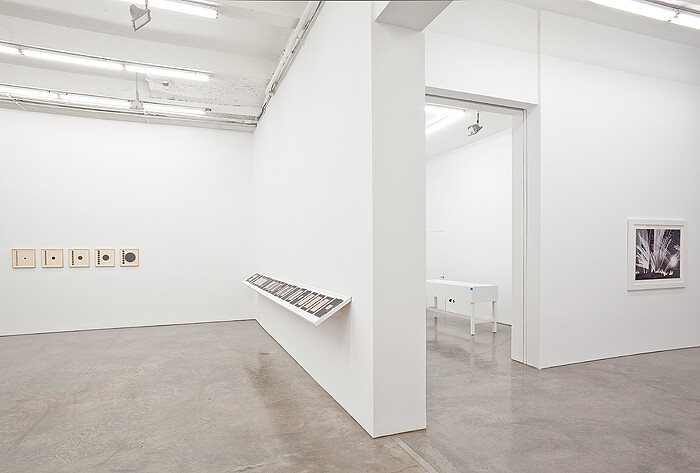Categories
Subjects
Authors
Artists
Venues
Locations
Calendar
Filter
Done
October 14, 2016 – Review
Matthew Barney’s "Facility of DECLINE"
Thyrza Nichols Goodeve

“Facility of DECLINE” at Gladstone Gallery, New York, “mirrors but does not reproduce” Matthew Barney’s iconic 1991 exhibition of the same name at the gallery’s SoHo space. Immediately upon entering, one is immersed in Barney’s now familiar yet ever fantastic world of petroleum jelly, mythic characters, seductive hermeticism, and ever-revelatory aesthetic invention: the signature hermetic conceptual drawings in self-lubricating plastic frames and petroleum jelly (rendered in graphite with that gorgeous, light, sinuous, even awkward Old Master hand); Caucasian flesh and bright yellow wrestling mats; football and weightlifting paraphernalia; speculums; cast sucrose capsules and barbells; saltwater pearls; an NFL jersey numbered “00”; thermal retractors, red skeets, binding belts, a hydraulic jack with glucose syrup; a “hubris pill”; various electronic freezing devices; numerous references to Oakland Raiders football star Jim Otto; Harry Houdini, dubbed “the Character of Positive Restraint”; and the melancholy intersex diva TRANSEXUALIS (1991), a weightlifting bench cast in petroleum jelly and enclosed in a walk-in-cooler.
Twenty-five years after its first exhibition this critical early work—which transformed Barney from a recently graduated pre-medical student into one of the most astonishing and influential artists of the 1990s—is not only alive and well, but finally has its moment. What was ungraspable, eccentric, and …
November 5, 2014 – Review
Jean-Luc Mylayne’s “Chaos”
Thyrza Nichols Goodeve

Our contemporary ontology is one of acceleration and mania. Along with the logic of global and cognitive capitalism, we look to our iPhones and the internet as the source for these intensified temporalities. Indeed, walk out on any street and hundreds of individuals are engaged in locating their sense of self and place via the rapid click of the cell-phone snapshot. Jean-Luc Mylayne’s 38-year oeuvre of patiently staged conceptual nature photography is the philosophical inversion of this state. Famous for his extensive labor and Zen-like patience, not to mention the huge amounts of time and ethical sensitivity he invests in creating his images of birds (as if that is all he is doing), Mylayne has more in common with Proust’s distended moments of reflective memory than the manic attention deficit of today’s amnesiac iPhone present. In fact, while preeminently photographic, his work calls more upon the fixed, contemplative gaze of modernist cinema and Bergsonian duration than upon the gee-whiz gimmickry of still digital photography. And yet Mylayne has also been linked to a new ethics of animal studies, since his work depends upon trust and mutual recognition, not force or artificial hierarchies of human versus animal. These “bird photographs” are …
October 15, 2013 – Review
Damián Ortega
Arnaud Gerspacher

If language is a tool then two things follow: there was a time before the tool was useful, hanging in a pre-anthropological state of potential, and there may come a time when it once again becomes useless. Similarly, if the sign is arbitrary, then there was a time before it settled on its current referent and the moment may come when it detaches itself again from it, like obsolete code. This sort of speculative linguistic archaeology—taking its cue from Wittgenstein and Saussure—finds an imaginative, sculptural dramatization in Damián Ortega’s new work at Gladstone Gallery. As the consummate bricoleur, Ortega redirects his affinity for assembly and disassembly of objects onto systems of language, uncovering the complex relations between materiality, symbolism, inscription, and the perception of meaning resulting from their interaction.
The centerpiece of the show is Harvest (2013), a large installation of some twenty steel sculptures hovering mid-air and evenly distributed throughout the main space of the gallery. Thin shapes tracing lines in space, they read like corrugated tire irons crossed with cobras in suspended animation. Their appearance straddles the line between objects of human techné and organic shapes resulting from nonhuman forces, like the speculative first bone-tool in Stanley Kubrick’s 1968 …
July 14, 2011 – Review
"The Unfinished Film"
Media Farzin

“Am I going haywire? Seriously. Am I going to finish the goddamn thing?” Hollis Frampton was frequently anxious about his monumental Magellan film project. “If you don’t finish an epic poem it is a more or less magnificent ruin,” he said. “This I probably have got to finish or I have blown the whole thing, in my own mind, since it has the problem of establishing its own context.” Frampton’s decade of work was cut short by his death in 1984, and his 36-hour-long “resynthesis of the film art” remains incomplete.
Magellan is one of the many “unfinished” film works featured in Gladstone Gallery’s current summer show, which is guest-curated by Thomas Beard, who is better known as co-director of New York’s experimental film venue Light Industry. In its own subjective way, the exhibition provides Frampton’s work with precisely the kind of context he couldn’t have dared to hope for—a selective take on film history that is both informed and open-ended. The central element of the show is the black box space, where films are projected according to a weekly schedule, starting at 3 pm daily. The rest of the gallery is host to a small group of objects related …
February 21, 2011 – Review
Kai Althoff’s, "Punkt, Absatz, Blümli" (period, paragraph, Blümli), at Gladstone Gallery, New York
Paddy Johnson

There’s something slightly strange about walking into an installation designed to look like a homemade living room in every way but the lighting. In the case of Kai Althoff at Gladstone Gallery, the cement floor painted bright yellow doesn’t exactly scream domesticity either, but the artist has integrated enough interior design elements that the florescent lights hanging from the lowered ceiling is disconcerting. Why arrange a raised nappy rug, a series of paintings in the style of Otto Dix and George Grosz, and a dividing wall of painted plaster mugs as if they were part of a household if they are to be lit like a gallery object in… a Subway sandwich store?
The answer to this question doesn’t come from the gallery’s press release, which is purely descriptive, but from the objects themselves: everything is a half-revealed mystery; a personal or private act made kind-of public. The results of such arrangements are predictably mixed. Take the references to religion scattered throughout the show: a watercolor portrait of a Jewish man hangs in the main exhibition space, and in a semi-private corner there is a pile of objects presumably used for worship. We never learn what the artist’s relationship to religion …
